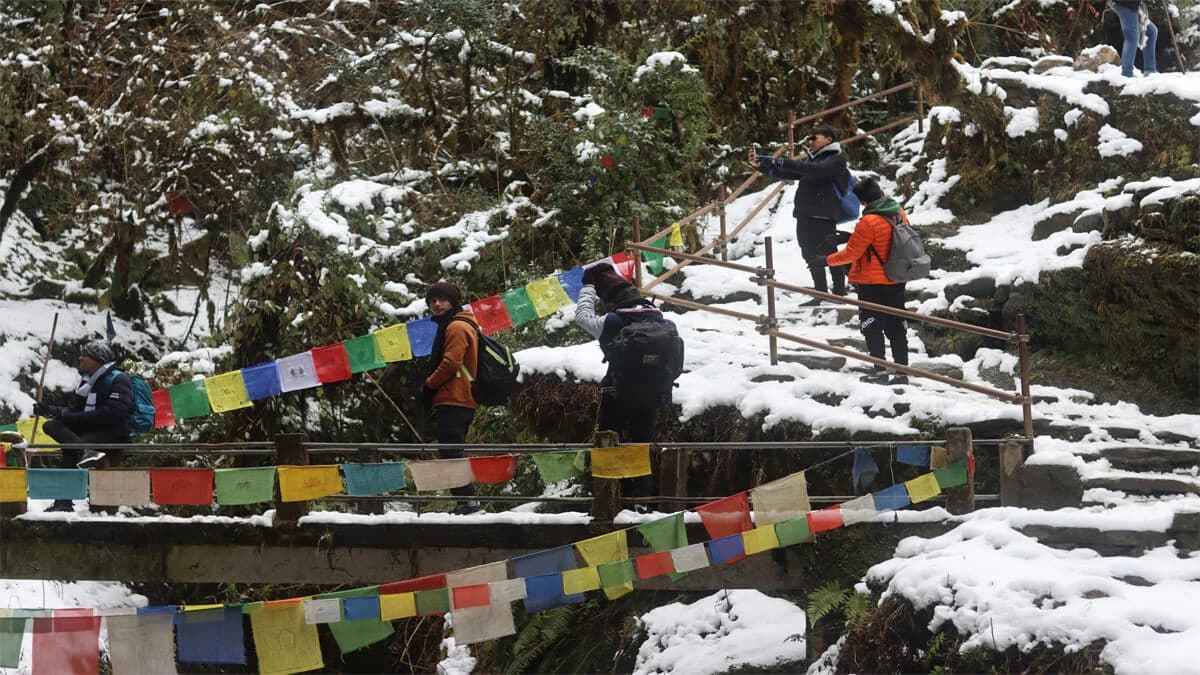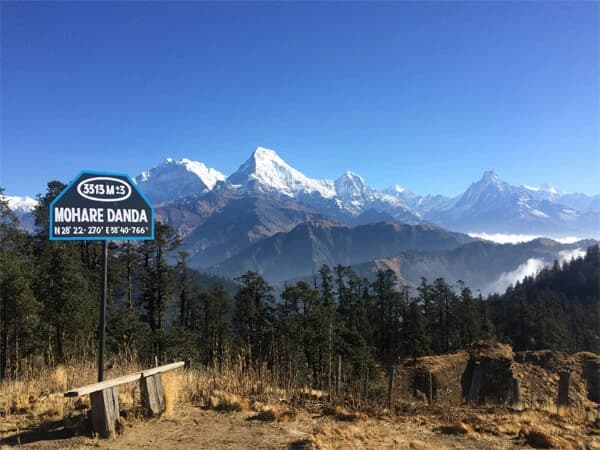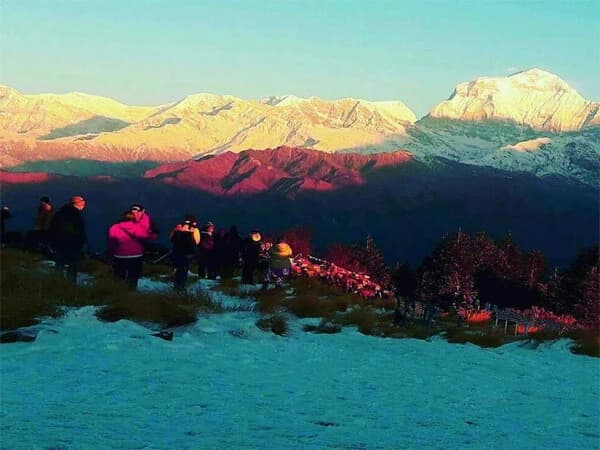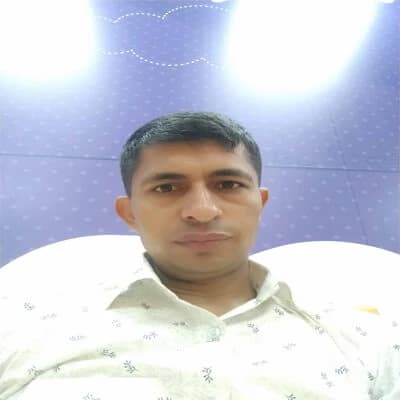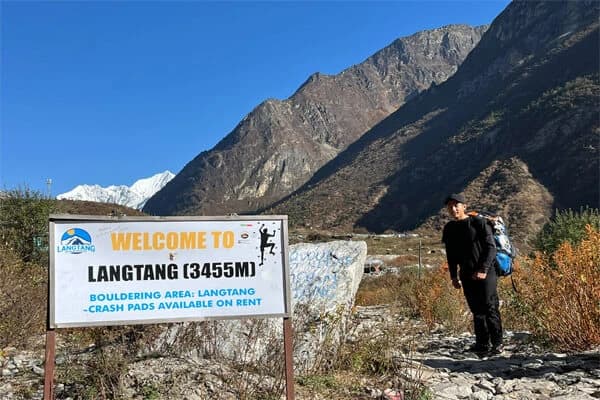Khopra Danda is a rare trekking route in the Annapurna Region. Its pristine natural beauty is unspoiled and remote compared to other popular routes like Poon Hill and Muktinath. It is an off-the-beaten-path trekking route in the Annapurna region. It is an ideal trek for those who want to experience the best panoramic mountain views, diverse landscapes, and local village life of the country.
Ultimate Guide to Khopra Danda Trek
If you are considering Khopra Danda Trek, Nepal Trekking Routes is a trusted local trekking agency that provides great service. We offer personalized itineraries, experienced guides, and support during your journey.
Key highlights of Khopra Danda Trek
Stunning Mountain Panoramas:
The panoramic view of the towering Himalayan Peaks including Annapurna, Nilgiri, Machhapuchhre, and Dhaulagiri Ranges is as stunning as any other Annapurna route. From Khopra Danda, you’ll experience the quiet environment which is perfect for soaking in the grandeur of the Himalayas.
Off-the-Beaten-Path Experience:
The trail is the less crowded and quieter corner of the Annapurna Region. The trek can be enjoyed in peace without the pressure of other trekking groups on more busy trails. The quiet trails enhance the sense of connection to nature while walking through lush forests and climbing high ridges.
Sacred Khayer Lake:
The trek includes an optional hike to the sacred Khayer Lake (4,560m) for those seeking an extra challenge. This day hike offers stunning views and a deeper spiritual connection to the region.
Authentic Local Culture:
The khopra trek takes you through Magar and Gurung villages offering a chance to experience the warm hospitality and local way of life. You can support the local economy by staying in the local teahouses.
Khopra Danda Trek Overview
The Khopra Danda Trek is a new and less-traveled route in Nepal’s Annapurna Region. The trails are quiet and the mountain views are spectacular. It is perfect for trekkers looking for adventure in nature without the heavy crowds found in popular treks like the Annapurna Base Camp or Poon Hill Khopra Danda.
Location:
The Khopra Danda trek is located in the Annapurna Region of central Nepal near the lake city Pokhara. It lies to the east of the Ghorepani-Poon hill trek. The trailhead starts at Nayapul or Ghandruk. The trail goes through diverse landscapes, from dense rhododendron forests to terraced farmlands, then ascends towards Khopra Danda. The trek provides close-up views of some of the famous Himalayan Peaks, including Dhaulagiri, Annapurna South, Machhapuchhre, and Nilgiri.
Difficulty:
The Khopra Danda trek is a moderate trek and is suitable for different skill levels of trekkers including beginners and intermediate trekkers. It is a short trek perfect for all ages. The daily ascents and descents can be challenging for those who are new to trekking. Trekkers should be physically fit and be prepared to walk for 6-8 hours a day. The trail includes both well-defined paths as well as some rugged sections as you climb higher towards Khopra Ridge.
Duration and Distance:
The Khopra Danda Trek takes around 11 days to complete. It takes 4 hours to 8 hours of walking for a day which may vary each day. The overall distance covered by the trail is approximately 70km depending upon the starting and ending points. Most trekkers start at Nayapul and finish at Ulleri, but the trek can be extended or shortened depending on the trekker’s physical ability and time available. You will pass through villages like Ghandruk, Tadapani, and Swanta adding cultural experiences to the journey.
Elevation:
The trek starts from Tadapani at an altitude of 2,630m and reaches a maximum elevation of 3,669m at Khopra Danda. It offers breathtaking panoramic views of the surrounding Himalayan peaks. The elevation is not as extreme as other higher-altitude treks in Nepal. The gradual ascent will help you acclimatize. Those who seek additional challenges can hike to Kayer Lake which is at an elevation of around 4,560m.
Why Choose Khopra Danda Trek?
You should choose Khopra Danda Trek because it is unique in several aspects. The route is less commercialized and quieter than the popular Annapurna Circuit or Everest Base Camp. It offers a blend of natural Himalayan beauty, culture, and a peaceful trekking experience. If you are looking for a trek that offers majestic mountain views, vibrant forests, tranquil trails, and authentic village life, then Khopra Danda should be on your list. Here are your reasons to choose
Authentic Village experience
Khopra Danda brings you closer to local village life. You will pass through traditional Gurung and Magar Villages where you can experience warm hospitality, rich culture, and connection with the people. You will get a chance to observe their daily life and cultural heritage. You’ll stay in community-run lodges, which support the local economy. This makes tourism more sustainable and responsible.
Spectacular Mountain Views
One of the features of the Khopra Danda Trek is the spectacular panoramic views. From the Khopra Danda, you will be treated to stunning views of the Dhaulagiri, Annapurna, Machhapuchhre, and Nilgiri ranges. You can enjoy these views without the hustle of busy trekking routes. It allows you to soak in the natural beauty at your own pace.
Off-the-Beaten-Path Adventure:
Khopra Danda Trek is a perfect choice for those seeking solitude and a less-commercialized route. The Ghorepani-Ghandruk Trek is very popular and can be more crowded. Khopra Danda offers an off-the-beaten-path experience where you can walk in peace enjoying nature. The trail is less crowded which brings you closer to the wilderness.
Diverse Landscapes:
The Khopra Danda Trek takes you through diverse landscapes from dense forests and terraced farmlands to alpine meadows and rocky ridges. You can view different scenes every day. During the Spring season, the rhododendron forest blooms with vibrant colors which
Khayer Lake:
If you are looking for extra adventure, you can visit Khayer Lake. The journey to this secluded alpine lake is challenging. It is situated at an altitude of 4,560m and is a sacred place for Hindu devotees. You can have a closer look at majestic peaks including Annapurna and Dhaulagiri.
Best Time to Trek to Khopra Danda
The Khopra Danda Trek offers stunning views and cultural experiences throughout the year. Choosing the right season can affect your trekking experience. Each season offers unique conditions. The best time to trek depends on factors like weather, temperature, visibility, and trail conditions. Here are the details of what it's like to trek in each season:

Khopra Danda Trek in Spring season (March to May):
Spring is an ideal season to trek Khopra Danda for nature lovers. You will see blooming rhododendrons which turn the forest into a colorful canvas.
- Weather: The weather is great and comfortable for trekking. The temperature is mild and pleasant. It ranges from 10°C to 25°C at lower altitudes and cooler at higher altitudes.
- Flora: The highlight of spring trekking is the colorful rhododendron forests. The blooms cover the hills in various colors including hues of red and white.
- Visibility: The sky is clear and visibility is good. The humidity increases due to the approaching summer, so it may not be as crystal clear as in autumn.
Khopra Danda Trek in Autumn Season (September to November):
Autumn is considered the best time to trek in Nepal. Khopra Danda trek in autumn has clear skies which is perfect for mountain views.
- Weather: The weather is cool and comfortable. Temperature ranges from 10°C to 20°C at lower altitudes and colder at higher altitudes.
- Views: Autumn has a clear view of the surrounding peaks, including Nilgiri, Dhaulagiri, Annapurna, and Machhapuchhre. There is a very good opportunity for photography.
- Crowds: The trail is quieter than the other popular routes. However, autumn attracts more trekkers due to its ideal conditions.
Khopra Danda Trek in Winter (December to February):
The winter season is peaceful but with colder temperatures at higher altitudes.
- Weather: Daytime temperatures are tolerable at lower altitudes but at higher altitudes, it can drop below freezing temperature. If you dare to trek in winter, make sure to wear proper trekking gear to protect yourself from the cold.
- Snow: Be prepared for snow at higher altitudes. The trails can get blocked by snow, making it challenging to walk.
Monsoon (June to August):
Monsoon offers lush greenery but also heavy rain and leeches. The trails will be slippery and mudslides will make it hard to walk.
- Weather: In monsoons, frequent rain can make it difficult to trek. The trail condition will be worse.
- Views: The mountain views are obstructed by clouds. Leeches are common in lower altitudes.
Detailed Itinerary
Here is the breakdown of the trek itinerary:
- Arrival in Kathmandu: On your arrival, you will be transported to a hotel in Thamel. You can rest and relax.
- Kathmandu to Pokhara: You will travel from Kathmandu to Pokhara via. Flight or a tourist bus depending on your preference. Drive to Tadapani via Ghandruk From Pokhara, you will travel to Tadapani via Ghandruk. Ghandruk is a Gurung village where the Gurung ethnic community showcases its culture and tradition through Museums and warm hospitality.
- Tadapani to Dobato:From Tadapani, you will walk through oak, bamboo, and rhododendron forests. You will have breathtaking views of the Annapurna and Dhaulagiri Ranges.
- Dobato to Khopra Danda: You will walk towards Khopra Danda passing through Bayali, then Chistang Village. You will descend from Chistang and reach Khopra Danda while enjoying the view of the sunset.
- Hike to Khayer Lake and trek back to Khopra Danda: You will hike to Khayer Lake, situated at an altitude of 4,560m. During your 8-hour hike, you will see the Dhaulagiri Range, the world’s deepest George Kali Gandaki, and other mountains. There is a small temple at the shoreline of Khayer Lake which is visited by many pilgrims.
- Khopra Danda to Swanta: You will walk through dense forests of bamboo and oak to reach Swanta. Swanta is a village surrounded by a large plot of agricultural land. There are few teahouses run by locals.
- Swanta to Ghorepani: From Swanta, you will trek towards Ghorepani. You will pass through rivulets and wooden bridges. Ghorepani is the largest Gurung village which provides food and accommodation in the teahouses. You can experience modernization in this village with authentic traditions and culture.
- Ghorepani to Ulleri and Drive to Pokhara: From Ghorepani, you will walk toward Ulleri, a village with a magar community. You have to climb the famous 300-stone staircases leading to Ulleri. From Ulleri, you will drive towards Pokhara in a private jeep. You can take some time to visit Lake City Pokhara before you go back to Kathmandu.
- Pokhara to Kathmandu: You can either take a flight or a tourist bus to travel from Pokhara to Kathmandu. After reaching Kathmandu, you can take a rest and have a farewell dinner before your departure.
- Final Departure: You will be transported to Tribhuwan International Airport, to board a flight. You will head back to your home with lots of memories of the trek.
Khopra Danda Trek Difficulty and Preparation
Who is this trek suitable for?
The Khopra Danda Trek is moderately difficult. The trek is suitable for most trekkers with good physical and mental fitness with trekking experience. It does not need technical climbing skills but involves long days of walking, steep ascents, and altitude challenges. With proper preparation, you can enjoy and succeed in the trek.
Khopra Trekking Experience:
Although the Khopra Danda Trek is suitable for beginners, it is recommended that trekkers have previous trekking experience of multi-day hikes. The trail includes gradual as well as steep ascents. It is beneficial if you are familiar with walking for 5-7 hours a day. First-time trekkers should consider hiring a guide from a local trekking agency, Nepal Trekking Routes for additional support and navigation.
Altitude Considerations and Acclimatization Tips
The trek reaches an elevation of 3,668m at Khopra Danda. During the trek, you will be at altitudes over 3,000m for three days. You should be concerned about altitude sickness although the altitude is lower than other treks. Make sure you acclimatize properly and listen to your body to prevent Acute Mountain Sickness (AMS).
- Go Slow: You should go slow and take it easy as you gain altitude. Climbing gradually helps your body adjust to the thin air.
- Keep yourself hydrated: Drinking plenty of water helps in acclimatization.
- Rest Days: Take rest days for acclimatization if needed at villages like Tadapani or Chistang
- Symptoms: Be aware of early symptoms of altitude sickness like headaches, dizziness, or nausea. Descend immediately if they worsen.
Physical Preparation:
You should do the necessary physical preparation for the trek.
- Cardio Training: We suggest you do aerobic exercises to improve your endurance. Include running, swimming, or cycling.
- Strength Training: Do leg, core, and back strength exercises to build up the muscles. Include squats and lunges for steep climbs and descents.
- Hiking Practice: Practice walking long distances with a backpack for long hiking days
Common challenges
- Steep ascents and descents: Despite the altitude, the conditions of the trail are rugged, with steep ascents and descents. You have to overcome these while trekking.
- Weather: The Himalayan weather is unpredictable. It varies from time to time. It may be windy during the day and extremely cold at night.
- Limited Facilities: As the trek passes through high altitude and remote areas, facilities like food, accommodation, and medical help can be basic and limited.
Permits and Regulations
Khopra Danda Trekking Permits
You will need an Annapurna Conservation Area Permit (ACAP) and Trekkers Information Management System (TIMS) Card for the Khopra Danda Trek.
- Annapurna Conservation Area Permit costs Nrs. 3000 or $25. You can obtain the permit in Kathmandu or Pokhara.
- TIMS Card costs NRs. 2000 per person and can be obtained at the offices of the Nepal Tourism Board in Kathmandu and Pokhara, TAAN Secretariat at Maligaon, and TAAN Pokhara Secretariat in Pokhara by filling up a TIMS Application form.
If you are trekking with Nepal Trekking Routes, we will help you arrange these permits.
Rules and Guidelines
- Trekkers should hire local guides and porters for treks in the Himalayan Region.
- Trekkers must obtain the necessary permits.
- Trekkers must acclimatize properly before starting the high-altitude trek.
- Trekkers must walk on the designated trail and not wander off too far.
Accommodation and Food
Khopra Danda Trek provides a memorable experience of local hospitality through its food and accommodation. Although the trek is off-the-beaten-path compared to other popular treks, you can find comfortable accommodation and food in the community-run teahouses and lodges.
Accommodation:

The accommodation on Khopra Danda Trek is basic but comfortable. Trekkers can stay in community-run teahouses and lodges with simple rooms and shared facilities. These lodges are managed by local villagers. You will get a glimpse of local culture and tradition while enjoying the warm hospitality.
Rooms: Rooms are simple with twin beds with mattresses, blankets, and pillows. The rooms may not have heating, making it colder at night, so take a sleeping bag along or rent extra blankets.
Facilities: Most teahouses have shared bathrooms with basic toilets. Hot showers are available at an extra charge. As you go to higher altitudes, the accommodations may have limited facilities.
Food:
Food plays an important role in the Khopra Danda Trek. The meals served in local lodges are traditional Nepali food. You may also find other options including western and continental.
- Dal Bhat: The staple meal is Dal Bhat, a combination of rice, lentil soup, and Vegetable Curry. It is simple, nutritious, and gives plenty of energy for trekking. The best part is the unlimited refills.
- Seasonal Vegetables: Many of the villages offer locally grown organic vegetables from their fields.
- Western Meals: Some lodges offer Western meals like pancakes, pasta, omelets, and fried rice.
- Local Specialties: Some lodges offer other options like momos, noodles, and local delicacies like yak cheese or home-brewed raksi (a local alcoholic drink).
The cost of accommodation can be around $60 per day including breakfast, lunch, and dinner.
Packing List and Gear
For successful trekking, you must prepare essential trekking gear and a packing list. Here is a list of essential gear and items :
Clothing:
- Base Layers: Moisture-wicking t-shirts and long sleeves to keep you dry during daytime hikes.
- Insulating layers: A warm fleece or down jacket for chilly mornings and nights.
- Outer Layer: A windproof and waterproof jacket to protect from wind and rain.
- Trekking Pants: Lightweight, quick-drying pants for trekking and thermal pants for colder nights.
- Socks: A few pairs of socks to prevent blisters.
- Gloves and Hat: Warm gloves and hats for warmth.
- Sun Hat and Sunglasses: A wide-brimmed hat and UV-protected sunglasses
Footwear:
- Trekking Boots: Sturdy, comfortable, and waterproof trekking boots with good ankle support for rocky and uneven trails.
- Camp Shoes: Lightweight shoes or sandals for relaxing at the lodges.
Gear and Equipment
- Trekking Poles: Helpful for balance and knee support during steep ascents and descents.
- A sleeping bag: A warm sleeping bag rated for -10 °C, as nights at Khopra Danda can get cold.
- Backpack: A comfortable backpack with good support and rain cover for carrying essentials during the trek.
- Water bottle and purification tablets: A reusable water bottle and water purification tablets to refill from streams and lodges.
- Headlamp: A headlamp with extra batteries for night and early morning starts.
Other Essentials:
- Personal items: Basic toiletries, sunscreen, lip balm, a first aid kit, and blister care medicine.
- Snacks: Energy bars, nuts, or dry fruits for a quick energy boost during the trail.
- Cash: There are no ATMs along the trek, so bring enough Nepali rupees to cover extra expenses like meals, hot showers, and tips.
Getting to the Starting Point
After you arrive in Kathmandu, the Khopra Danda Trek begins in the Annapurna region of Nepal. There are several possible starting points depending on your itinerary. The most common starting points are Nayapul, Ghandruk, or Tadapani which are accessible from Pokhara. There are various modes of transportation to get to the starting point of Khopra Danda Trek.
Step 1: Getting to Pokhara
The Khopra Danda Trek starts from Pokhara, a beautiful lake city that is a gateway to the Annapurna region. Here is how you can travel from Kathmandu to Pokhara:
- By Flight: You can take a domestic flight from Kathmandu to Pokhara. It is the quickest option as you can reach within 25-30 minutes. You will enjoy the aerial view of the Himalayas during clear days.
- By bus: For budget travelers, tourist buses from Kathmandu to Pokhara are a popular choice. It takes about 6-8 hours to travel through a winding road, and scenic landscapes including rivers, terraced fields, and villages.
- A private vehicle: Depending on your preference, you can hire a private car or a jeep for comfort and flexibility to travel by road which takes about 6-7 hours.
Step 2: Getting to the Starting Point
After you arrive in Pokhara, you will travel to the starting point, usually Nayapul, Ghandruk, or Tadapani. To get to the starting point, you will travel by road from Pokhara. Here is how you can travel:
- Public Bus or Jeep: You can take a public bus or shared jeep from Pokhara to Tadapani. Public buses are the cheapest option but can be crowded. Jeep can be more comfortable and faster.
- Private Jeep: You can hire a private jeep for convenience. It will take you directly from your hotel in Pokhara to the trailhead. This is ideal if you are traveling in a group.
Trekking with or without a Guide
Deciding whether to trek the Khopra Danda route with or without a guide depends on your trekking experience, physical fitness, comfort level, and preference for adventure. Both options offer a unique experience. It is better to trek with an experienced and licensed guide. A guide has local knowledge and can provide information about the trail. They can help you communicate with the locals and exchange culture and language. The cost of hiring a guide is around $30-$40 per day.
Benefits of Trekking with a Guide:
Local Knowledge and Expertise:
A professional guide from Nepal Trekking Route provides valuable expertise and local knowledge. Guides are skilled in navigating the terrains and are familiar with the weather patterns, trail conditions, and safety measures. They can provide you with information about the local culture and help you communicate and understand the local communities.
Safety and Support:
There can be unexpected challenges while trekking such as altitude sickness, unpredictable weather, or route confusion. A guide keeps you safe by monitoring your health and making decisions in critical situations. A knowledgeable guide provides access to immediate help, including first aid or logistical adjustments to the trek.
Cultural Exchange:
A guide from local agencies like Nepal Trekking Routes can offer the opportunity to engage with the local community. They can facilitate cultural exchange, explain customs, introduce you to village life, and help you carry out meaningful interactions with the Gurung and Magar people along the trail.
Convenience:
Trekking with a guide provides you with the convenience of logistics like accommodation, food, permits, and transportation. Nepal Trekking Routes arranges everything, allowing you to enjoy the trek.
Khopra Trekking without a Guide:
Khopra Danda Trek can be a rewarding experience for experienced trekkers who can navigate unfamiliar trails. You can have an independent adventure while exploring the quiet off-the-beaten-path route. There are a few factors to consider:
Navigation Challenges:
Research your trek before you decide to start. Some sections of the trail can be confusing at higher altitudes or during bad weather. While trekking solo, you will need maps, and GPS or ask locals for directions, which can be time-consuming and stressful.
Logistics and Permits:
Plan and prepare logistics and permits adequately. Without a guide, you need to handle all the logistics yourself, including arranging transportation, securing permits, and booking accommodation in advance during peak seasons.
Safety Considerations:
Do not make hasty decisions while trekking without a guide. Khopra Danda is remote and risky when trekking solo. You should be extra vigilant about your safety and well-being as there will not be anyone experienced to assess your health and altitude sickness.
Cultural and Environmental Considerations
Khopra Danda Trek provides an opportunity to experience the rich culture and traditions of local Gurung and Magar villages. You should consider responsible trekking in Nepal and Leave No Trace principles to protect the local environment. You should understand the cultural and environmental aspects of the trek which will make your journey respectful and sustainable.
Cultural Considerations: Gurung and Magar Villages
The Khopra Danda trek passes through charming villages populated by ethnic communities, primarily Gurung and Magar. These Gurung and Magar villages have distinct cultures and close-knit communities. It is important to approach these communities with respect while interacting with them. To deepen your understanding of the culture you should consider these aspects:
- Respect Local Customs: Both the Gurung and Magar people have specific traditions and practices regarding religious sites. Be mindful of common etiquette like removing shoes before entering a home. Always ask for permission before taking pictures in temples and homes.
- Support Local Business: The teahouses and lodges are run by the local communities. Choosing to stay in these places and purchasing local products like handicrafts or food supports the local businesses. Your contribution sustains the local economy.
Environmental Considerations: Responsible Trekking
Khopra Danda is located in the Annapurna Conservation Area. You should be responsible for minimizing your environmental footprint while trekking there. The area has fragile ecosystems and tourism can affect either positively or negatively.
- Leave No Trace Principle: Always follow this principle. Pack your trash, avoid using plastic bottles, and carry a reusable water bottle and purification tablets.
- Energy Conservation: In remote lodges, there are limited resources like firewood and electricity. Save water and energy by avoiding the use of firewood which causes deforestation.
Environmental Challenges:
The region faces environmental challenges including deforestation, waste management issues, and wildlife protection. As trekkers, practice eco-friendly trekking habits, support sustainable tourism, and contribute towards the protection of this beautiful nature for future generations. By hiring local guides and porters, transportation, food, and accommodation services, you help the local businesses to sustain. By paying for an ACAP permit, you will help with wildlife conservation efforts.
Conclusion
Khopra Danda Trek is a short and exciting trek through the less traveled route of the Annapurna region of Central Nepal. It is worth considering for beginner and intermediate-level trekkers. You can enjoy the panoramic view of Himalayan peaks, and beautiful landscapes and engage with the authentic local culture.
Nepal Trekking Routes, a well-known local trekking agency, can provide guidance and support for your trekking journey. You can gain access to expert navigation, safety measures, and cultural insights while supporting local businesses. So, pack your bags and lace up your boots for an off-the-beaten-path trek to Khopra Danda.

